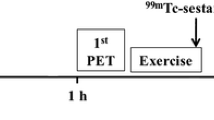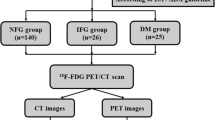Abstract
To quantify myocardial glucose metabolism by 18F-FDG PET/CT in patients that have coronary heart disease (CHD) according to traditional Chinese medicine classification. Ninety patients with CHD were enrolled and were categorized into three groups. All patients underwent PET-CT examination for 18F-FDG uptake quantification. In group A, the radioactive signals were weak in multiple segments in 27 cases (90 %). One case had no visualization and two had normal visualization (mean SUV = 4 ± 0.6). In group B, the radioactive signals were in some local areas in eight cases (26.7 %). Twenty cases had an overall increase in signal density (SUV ≥ 8) (66.7 %). One case had no visualization, and one case had normal visualization (mean SUV 4 ± 0.6). In group C, 23 cases had no visual or a weak visual (SUV ≤ 2 ± 0.3) (76.7 %). Seven cases had segmental weak signals or signal defects. Different types of CHD demonstrate different metabolisms of myocardium glucose. It is necessary to dialectically classify CHD and apply differential treatment.



Similar content being viewed by others
References
Maes, A., Flameng, W., Nuyts, J., et al. (2009). Histological alteration in chronically hypo perfused myocardium: Correlation with PET findings. Circulation, 90, 735–745.
Kolodgie, F. D., Petrov, A., Virmani, R., et al. (2010). Targeting of apoptotic macrophages and experimental atheroma with radiolabeled annexin V. A technique with potential for noninvasive imaging of vulnerable plaque. Circulation, 108, 3134–3139.
Davies, J. R., Rudd, J. H., & Weissberg, P. L. (2010). Molecular and metabolic imaging of atherosclerosis. Journal of Nuclear Medicine, 45, 1898–1907.
Rudd, J. H., Warburton, E. A., Fryer, T. D., et al. (2002). Imaging atherosclerotic plaque inflammation with [18F]-fluorodeoxyglucose positron emission tomography. Circulation, 105, 2708–2711.
Schelbert, H. R. (2010). The usefulness of positron emission tomography. Current Problems in Cardiology, 23, 69–120.
Machac, J. (2010). Cardiac positron emission tomography imaging. Seminars in Nuclear Medicine, 35, 17–36.
Klocke, F. J., Baird, M. G., Lorell, B. H., Bateman, T. M., Messer, J. V., & Berman, D. S. (2011). Guidelines for the clinical use of cardiac radionuclide imaging–executive summary. Circulation, 108, 1404–1418.
Namdar, M., Hany, F., & Koepfli, P. (2010). PET-CT for the assessment of coronary artery disease. Journal of Nuclear Medicine, 46, 930–935.
Allman, K. C., Shaw, L. J., Hachamovitch, R., & Udelson, J. E. (2010). Myocardial viability testing and impact of revascularization on prognosis in patients with coronary artery disease and left ventricular dysfunction: A meta-analysis. Journal of the American College of Cardiology, 39, 1151–1158.
Eitzman, D., al-Aouar, Z., Kanter, H. L., vom, D. J., Kirsh, M., Deeb, G. M., & Schwaiger, M. (2010). Clinical outcome of patients with advanced coronary artery disease after viability studies with positron emission tomography. Journal of the American College of Cardiology, 20, 559–565.
Yonekura, Y., Tamaki, N., Senda, M., Nohara, R., Kambara, H., Konishi, Y., et al. (2010). Detection of coronary artery disease with 13N-ammonia and high-resolution positron-emission computed tomography. American Heart Journal, 113, 645–654.
Carli, M. F., Davidson, M., Little, R., Khanna, S., Mody, F. V., Brunken, R. C., et al. (2010). Value of metabolic imaging with positron emission tomography for evaluating prognosis in patients with coronary artery disease and left ventricular dysfunction. American Journal of Cardiology, 73, 527–533.
Lee, K. S., Marwick, T. H., Cook, S. A., Go, R. T., Fix, J. S., James, K. B., et al. (2009). Prognosis of patients with left ventricular dysfunction, with and without viable myocardium after myocardial infarction. Relative efficacy of medical therapy and revascularization. Circulation, 90, 2687–2694.
Baudouy, M., He, Z. X., Darcourt, J., Guignier, A., Ferrari, E., Bussiere, F., & Morand, P. (1993). Nitrates improve detection of ischemic but viable myocardium by thallium-201 reinjection SPECT [published erratum appears in J Nucl Med 2010 Nov; 34(11):2009]. Journal of Nuclear Medicine, 34, 1472–1477.
He, Z. X., Medrano, R., Hays, J. T., Mahmarian, J. J., & Verani, M. S. (2010). Nitroglycerin-augmented 201T1 reinjection enhances detection of reversible myocardial hypoperfusion. A randomized, double-blind, parallel, placebo-controlled trial. Circulation, 95, 1799–1805.
Prior, A. D., Quinones, M. J., Hernandez-Pampaloni, M., Facta, A. D., Schindler, T. H., Sayre, J. W., et al. (2011). Coronary circulatory dysfunction in insulin resistance, impaired glucose tolerance, and type 2 diabetes mellitus. Circulation, 111, 2291–2298.
Schindler, T. H., Nitzsche, E. U., Olschewski, M., Magosaki, N., Mix, M., Prior, J. O., et al. (2010). Chronic inflammation and impaired coronary vasoreactivity in patients with coronary risk factors. Circulation, 110, 1069–1075.
Wang, Q., & Ye, J. (2010). Experimental study on the relationship between hyperlipidemia and phlegm in traditional Chinese medicine. Chinese Journal of Basic Medicine in Traditional Chinese Medicine, 1, 52–54.
Park, J. O., Quinones, M. J., Hernandez-Pampaloni, M., Facta, A. D., Schindler, T. H., Sayre, J. W., et al. (2010). Coronary circulatory dysfunction in insulin resistance, impaired glucose tolerance, and type 2 diabetes mellitus. Circulation, 111, 2291–2298.
Friedman, T. F., & Rosenman, A. C. (2011). Depressive symptoms and risks of coronary heart disease and mortality in elderly Americans. Circulation, 102(15), 773–1779.
Go, R. T., Marwick, T. H., MacIntyre, W. J., Saha, G. B., Neumann, D. R., Underwood, D. A., & Simpfendorfer, C. C. (2010). A prospective comparison of rubidium-82 PET and thallium-201 SPECT myocardial perfusion imaging utilizing a single dipyridamole stress in the diagnosis of coronary artery disease. Journal of Nuclear Medicine, 31, 1899–1905.
Schindler, T. H., Nitzsche, E. U., Schelbert, H. R., Olschewski, M., Sayre, J., Mix, M., et al. (2005). Positron emission tomography-measured abnormal responses of myocardial blood flow to sympathetic stimulation are associated with the risk of developing cardiovascular events. Journal of the American College of Cardiology, 45, 1505–1512.
Acknowledgments
Supported by the Natural Science Fund Foundation of Jiangsu Province (NO BK2012647).
Author information
Authors and Affiliations
Corresponding author
Rights and permissions
About this article
Cite this article
Tan, Yy., Liu, Df., Zhu, F. et al. Analysis of Myocardial 18F-FDG Uptake by PET/CT in the Patients with Different Dialectically Classified Coronary Heart Diseases (CHD). Cell Biochem Biophys 72, 813–816 (2015). https://doi.org/10.1007/s12013-015-0538-3
Published:
Issue Date:
DOI: https://doi.org/10.1007/s12013-015-0538-3




